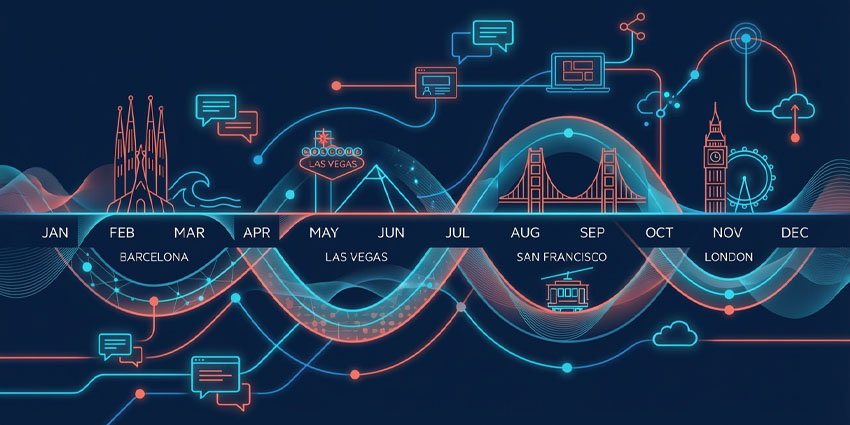In today’s hyper-competitive UC market, distinguishing between platforms has become increasingly challenging.
The lines between service offerings blur as vendors race to match and surpass each other’s features.
Yet, understanding these nuanced differences remains crucial for businesses making strategic communications decisions.
Migrations between platforms are not only technically complex but financially burdensome, often requiring substantial investments in training, infrastructure adjustments, and potential productivity disruptions during transition periods.
For organizations contemplating their UC strategy, the stakes couldn’t be higher. Selecting a platform that initially appears suitable only to discover critical feature gaps months into implementation can derail digital transformation initiatives and impact operational efficiency.
For instance, both Zoom and RingCentral stand as formidable players in the UC space, with superficially similar offerings that can make differentiation difficult at first glance.
Zoom, having leveraged its pandemic-fueled video conferencing dominance into a broader communications platform, now competes directly with RingCentral, a company with deeper roots in enterprise telephony that has expanded its portfolio to encompass comprehensive collaboration tools.
Their convergent evolution has created substantial overlap in capabilities.
However, beneath the surface similarities are meaningful distinctions in architecture, specialization, integration capabilities, and pricing models that can significantly impact suitability for specific business requirements.
To help businesses make the decision on what solution best meets their needs, we dive into these critical differences to provide clarity for decision-makers.
Core Communications and Meeting Capabilities
When examining foundational communications capabilities, both platforms offer robust video conferencing with HD audio and video support, screen sharing, and virtual backgrounds.
Zoom’s video infrastructure was built from the ground up for video optimization, which influences its performance characteristics in certain environments.
Its interface is also intuitive, which can affect adoption rates in organizations with diverse technical proficiency levels.
RingCentral Video features similar core functionality while maintaining close integration with its telephony services.
This integration creates a different user experience when transitioning between communication modalities.
For example, the process of escalating from a phone call to a video conference follows a different workflow in RingCentral’s ecosystem compared to Zoom, although both possess the capability.
Additionally, RingCentral’s browser-based experience has its own characteristics that distinguish it from Zoom’s approach.
Voice capabilities represent a notable differentiation point.
RingCentral’s heritage as a business phone system provider is reflected in its telephony feature set, offering call management features including multi-level auto-attendants, call queues with various routing options, whisper announcements, and call center analytics.
Its global voice footprint extends to numerous countries with local phone numbers available in over 100 regions, which differs from Zoom’s geographic coverage of local telephony service across 49 countries.
Meeting capacity represents another significant differentiation point between the platforms. Zoom offers tiered participant limits starting from 100 participants in basic plans up to 1,000 in enterprise packages for standard meetings, while their webinar functionality can accommodate in excess of 100,000 view-only attendees with add-ons.
RingCentral provides its own participant structure, with the most basic plan (standard) having video meetings supporting four participants (extendable with add-ons) and RingCentral Meetings Webinar is an add-on with up to 10,000 attendees.
The user experience and moderator controls differ between platforms, with similar capabilities, but distinct approaches to managing large audiences, polling, Q&A functionality, and presenter coordination.
Performance at scale presents another consideration, with each platform handling bandwidth challenges differently.
For global enterprises, the geographical distribution of data centers impacts meeting quality, with Zoom operating a global network of data centers while RingCentral leverages both its own infrastructure and partnerships for global coverage.
RingCentral, as a result, boasts less than six minutes of downtime annually for 16+ quarters and counting.
Collaboration Tools and Mobile Experience
Team messaging capabilities represent a fundamental differentiation point.
RingCentral offers its team messaging platform as a central component of its collaborative ecosystem, providing persistent chat rooms, threaded conversations, and task management tools integrated directly with its voice and video capabilities.
Zoom Team Chat approaches messaging from a different angle, with a design that evolved from its meeting-centric foundation, offering group messaging, file sharing, and integration with its meeting platform.
Collaboration tools beyond messaging show further differentiation. Zoom’s whiteboarding capabilities have expanded significantly in recent developments, offering multi-user annotation and persistent whiteboard spaces.
RingCentral provides its own collaborative whiteboarding tools with different interface characteristics. Both platforms support file sharing and collaboration, but with distinct approaches to organization and storage.
Task management features also differ substantially, with RingCentral incorporating more extensive native task management tools within its messaging environment, while Zoom takes a more integration-focused approach to project management functionality.
Mobile experiences differ significantly between the platforms.
Zoom’s mobile applications emphasize meeting participation with optimization for low-bandwidth environments, while RingCentral’s approach emphasizes its UC with more prominent telephony features, including specialized functions for business calling, such as advanced call flip between devices and dedicated car mode for safer driving.
Accessibility features vary between platforms as well, with each offering different implementations of closed captioning, screen reader compatibility, and keyboard navigation features. Device flexibility and cross-platform consistency create another point of differentiation. Both allow for access on a number of different devices, with Zoom maintaining generally consistent feature parity across devices while RingCentral’s feature implementation varies between desktop and mobile experiences.
Hardware, International Reach, and Enterprise Capabilities
Conference room solutions represent a major differentiation area.
Zoom Rooms follows a software-based approach working with various hardware components, while RingCentral Rooms provides its own approach to conference room integration with different certification standards.
Desk phone compatibility, although both possess this ability, highlights RingCentral’s telephony heritage as it supports an extensive range of SIP phones and traditional desk phones through its certification program.
Geographic service availability also meaningfully differs between platforms.
Zoom Phone is available in 47 countries with direct PSTN connectivity, while RingCentral’s voice services extend to over 40 countries plus additional coverage through international calling plans.
Language support also varies, with Zoom’s user interface available in 16 languages and RingCentral supporting 15 languages across its platform.
Security frameworks in both platforms have evolved significantly following increased scrutiny of remote collaboration tools.
Compliance certifications show substantial overlap, with both platforms maintaining SOC 2, HIPAA, GDPR, and other key certifications, though each offers its own compliance documentation and features for regulated industries.
Enterprise administration capabilities differ in structure and interface rather than just breadth.
Support models reflect each company’s approach as well, with RingCentral’s enterprise support including implementation assistance and technical account management options, while Zoom provides its own configuration of enterprise support offerings alongside self-service resources.
AI, Advanced Features, and Business Considerations
AI capabilities highlight different development priorities between the platforms.
Zoom’s AI allows things like searchable transcripts, talks broken down into chapters, and a chatbot to catch up with late entrants all through its AI Companion tool. It also provides live-translated captions in multiple languages, enhancing accessibility.
RingCentral integrates AI deeply across its UC platform, including real-time transcription, noise cancellation, and automated post-meeting summaries with highlight reels and action items.
Its AI-driven call routing and queueing adapt dynamically based on agent availability, optimizing call distribution.
Contact center capabilities highlight significant platform differences.
RingCentral offers a more mature contact center solution with extensive omnichannel routing and workforce management.
While Zoom Contact Center CCaaS, it is a newer entry to the market than RingCentral.
Zoom’s CCaaS platform emphasizes scalability and seamless integration with its UC ecosystem, leveraging AI Companion for real-time agent assistance, post-call summaries, and multilingual support.
It offers cost-effective cloud adoption and omnichannel routing (voice, SMS, web-chat, in-app chat, WhatsApp or Facebook).
RingCentral’s RingCX, powered by RingSense AI, offers workflow automation, including sentiment analysis, and auto-QA scoring.
Its workforce tools enable shift bidding and real-time supervisor intervention, while its hybrid model (RingCX or NICE-powered options) caters to enterprises with robust analytics and global reseller partnerships.
Both offer integrations (e.g., HubSpot, ServiceNow) to feed info in a dynamic way that presents and collects data during interactions.
Pricing models reveal different approaches to the market.
Zoom offers a structure with tiers based primarily on feature access, while RingCentral’s pricing has its own characteristics with variables based on specific feature combinations and user types.
For instance, both offer a free video plan—with RingCentral offering higher participant capacity and more minutes—but Zoom offers slightly more features as part of it.
Contract flexibility shows distinct approaches as well, with different options for term lengths and volume discounts.
Hidden costs and add-ons create further differentiation in total cost of ownership; for instance, RingCentral’s most basic paid video package costs around $12, but if adding on features like Webinars and Rooms, it can easily take the cost above $50.
Choosing the Right Platform for Your Future Needs
As the UC landscape continues evolving, the choice between Zoom and RingCentral depends on specific organizational priorities and requirements.
Organizations have different preferences regarding video experiences, telephony capabilities, team collaboration tools, mobile access, hardware integration, global reach, AI implementation, customer engagement tools, and cost models.
Successful implementations typically result from matching an organization’s specific communication requirements with a platform that aligns with those needs across all relevant dimensions.
Organizations benefit most when selecting their UC partner based not only on current features but also on how the platform aligns with their vision for communication’s role in their digital transformation journey.
With both putting eminence on both AI and omnichannel capabilities, the evolution of the service is one thing you can be sure of, whatever platform you pick.
Have thoughts to add? Join the conversation on LinkedIn or Reddit—we’d love to hear your perspective.







